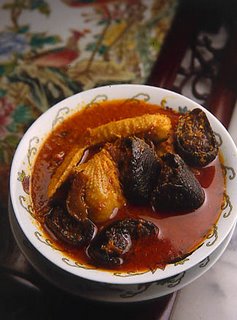My mother is a Nyonya, which is to say that she is part of that distinctive, historically significant and culturally rich group called the Peranakan (http://en.wikipedia.org/wiki/Peranakan). The Peranakan culture, is a lively blend of Chinese culture with the polyglot of local cultures found in the Straits of Malacca which from the 12th century onwards was a major crossroads of the spices trade. The cuisine is a similar blending of flavours with adaptations to local delicacies, fruits and vegetables. One specialty is the Buah Keluak and this has been for me, an all time favourite since childhood.
It is usually cooked together with chicken or with pork ribs to form a rich, spicy stew which is flavoured with spices and the buah keluak. Buah Keluak or the Keluak Fruit is a very special, geographically limited, rare and unusual ethnic food. It is not a fruit nor is it a nut, although it resembles a nut and is often mistaken as such. Instead it is a very toxic seed from a very toxic fruit of a very toxic tree but when properly treated and cooked, it is ambrosia. Some call it the “truffle of Asia”. I would best describe it as “savoury chocolate”. To be honest, it is like nothing else so any comparison is quite whimsical.
It is usually cooked together with chicken or with pork ribs to form a rich, spicy stew which is flavoured with spices and the buah keluak. Buah Keluak or the Keluak Fruit is a very special, geographically limited, rare and unusual ethnic food. It is not a fruit nor is it a nut, although it resembles a nut and is often mistaken as such. Instead it is a very toxic seed from a very toxic fruit of a very toxic tree but when properly treated and cooked, it is ambrosia. Some call it the “truffle of Asia”. I would best describe it as “savoury chocolate”. To be honest, it is like nothing else so any comparison is quite whimsical.

The Black Buah Keluak with Chicken
Buah keluak seeds come from the “football fruit” of the Kepayang tree or Pangium edule which is probably only found in Borneo, Sumatra and Malaysia. This forest tree can reach 60 m in height and has thick, waxy broad leaves. Almost every part of this tree and fruit are poisonous and in fact extract from the crushed seeds can be used to make poisoned tipped arrows. The reason for this is that the plant material is rich in cyanide or prussic acid. To prepare the seeds, they are often buried underground coated in ashes for as long as 40 days, then boiled and cleaned. This process should remove the poisons. Visit http://gardenerwork.blogspot.com/2006/10/buah-keluak.html for some good visuals of this unusual plant and its seeds.
For those who would like to try to cook this dish, I suggest you visit http://www.makansutra.com/Makanzine/Nov99/ayam_buah_keluak.html. Be warned, it is a lot of work. Once the buah keluak is prepared, a small opening needs to be created by using a cleaver. The buah keluak can then be cooked. The fleshy part should turn soft and black with a strong nutty flavour. Some master chefs insist on extracting the flesh, mixing it with a bit of meat and re-stuffing the flesh back into the seeds. This extra work ensures a more even and consistent flavour.
The cooked dish is served with rice. You would place one or two pieces of meat on a plate and liberally douse the rice with the flavourful sauce. Then take a buah keluak and using a chopstick or fork, extract the flesh from the seed. Mix the flesh with the meat, rice and sauce. Enjoy.
If served with this dish, I could easily consume up to five times my normal intake of rice because it just goes so well together. What makes this such a great culinary experience? 1. Its nutty flavour, 2. Its creamy texture, 3. Its heady aroma, 4. its rarity and uniqueness and 5. its contribution to a rich cultural history. The best way to try this is to visit Malaysia and ask around for a Peranakan restaurant or even better, befriend a Peranakan who knows the recipe and get invited home for dinner. Sorry, there isn’t any easy way to do this but it will be so worthwhile. Hurry, this great dish of my childhood is getting increasingly harder to find with each passing year and because of the rarity of the tree, this will truly remain a regional ethnic dish even in today’s global village.





1 comments:
yeah, miss the keluak pork dish my mum used to make. any idea where can i buy buah keluak in kl?
cheers
mgm
Post a Comment